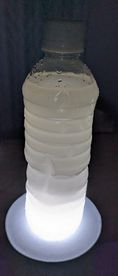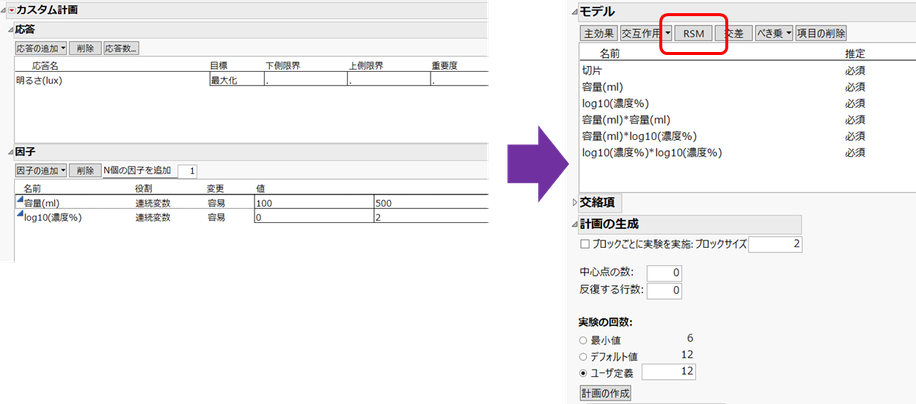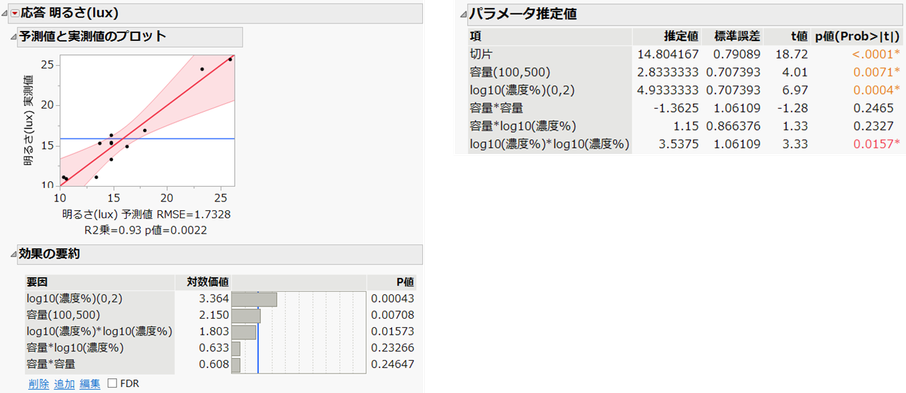本ブログシリーズのPart 1では、ペットボトルランタンの明るさに対する液体の種類、容量、濃度(常用対数に変換したもの)、そしてペットボトルの形状(ヒダヒダ、コーラ)の4つの因子を考慮したスクリーニング実験を実施しました。

実験の結果、容量、濃度、およびペットボトルの形状が明るさに影響を及ぼすことが確認されました。そこでPart 2ではスクリーニング実験の結果をもとに、災害時の実用性も考慮して、ヒダヒダのペットボトルにスポーツ飲料を入れてランタンとして使用する際の最適な容量と濃度を応答曲面モデルをあてはめることにより調べてみます。
参考:前回のブログ
実験計画法(DOE)で「ペットボトルランタン」を最も明るくする条件を調べてみる ~ Part1. スクリーニング実験~
最適化実験
「カスタム計画」を使って応答曲面モデルをあてはめる計画を作成してみます。以下のように応答と因子を設定し「モデル」では [RSM](Response Surface Model の略)ボタンをクリックして応答曲面モデル(主効果、2次の交互作用、2乗項を含むモデル)を指定します。実験の回数はデフォルト値である12回とし、[計画の作成] ボタンをクリックすると計画が出来上がります。

■実験データの入力、実験データの可視化
作成された計画について実験を行い、照度計をより読み取った明るさ(lux)を入力しました。
併せて、「グラフビルダー」で実験領域における実験点と明るさの関係を示したグラフを作成しました。この実験では
実験領域の頂点、軸点(各因子の下限、上限の真ん中の水準)、中心点が実験点となっています。このような計画は中心複合計画と呼ばれ、応答曲面をあてはめる際の代表的な計画です。

実験領域では右上(容量が濃度ともに大きい)の方が明るくなっているようです。
■分析レポート
応答曲面モデルをあてはめたときの分析レポートです。
- 「予測値と実測値のレポート」を見るとR2乗は0.93であり、赤い線(実測値と予測値が一致する領域)から大きく外れた実験点はないことがわかります。2つの因子で説明しているモデルの割には、あてはまりが良いモデルができています。
- 「パラメータ推定値」のレポートをみると、log10(濃度)の2乗項が有意になっている、すなわち曲面効果があります。

■予測プロファイル
予測プロファイルにて、明るさの予測値が最も大きくなる因子の条件を、[満足度の最大化] オプションを使って調べてみました。

ヒダヒダのボトルにスポーツ飲料を入れる場合、容量が500ml、濃度が100%のとき明るさは最大となり、その時の明るさは25.9(lux)であることがわかりました。
これより、ペットボトルランタンとしてスポーツ飲料を使うのであれば、特に容量と濃度を調整せずに未開封のものをそのまま使えば良いことがわかりました。
■等高線プロファイル
あてはめた応答曲面モデルを等高線でも可視化してみましょう。以下の「等高線プロファイル」は横軸を容量、縦軸をlog10(濃度)としたときの等高線です。さらに、明るさの予測値が20以上となる領域を白色で表しています。

もし明るさが20(lux)以上であれば十分とすると、白色の領域の範囲内で因子の設定値を検討すると良いでしょう。
もし半分ぐらい飲んでしまった(容量が250mlとなる)スポーツ飲料があったとしても、明るさは20(lux)以上になると予測されるので、十分な明るさが得られると考えられます。
確認実験
最後に最適条件など今後因子の設定したい条件で再度実験し、この測定値とモデルにより求められた予測値が近い値になっていることを確認してみました。
今回の例では容量500ml、濃度100%の条件のとき明るさが最大となったので、これまでの実験とは別に、再度この条件で明るさを測定したところ、測定値は25.5(lux)となりました。
予測プロファイルで求めた最適条件での予測値は25.9(lux)なので、測定値と予測値は近い値になっており、最適条件での明るさの再現性を確認できました。
素人なりに実験を行ってきましたが・・
2回に分けてペットボトルランタンの実験をご紹介しましたが、実験は案外大変でした。濃度や容量を調整が必要なので、自宅のキッチンで実施しました。薄暗い中で計量カップを使いながら濃度を調整したり、実験データを入力したりしていると、気が付いたら真夜中になっていましたし。。。
それにも関わらず、何とか皆様に説明できるぐらいの実験結果を得ることができました。ただ、私が行ったのは理科の自由研究レベルの実験なので、今回の結果が本当に正確なのか、再現性や一般化の可能性については疑問が残ります。興味のある方は、ぜひ実験してみてください。
ペットボトルランタンは非常時に適度な明るさを得る方法の一つです。是非覚えておくと良いでしょう。
by 増川 直裕(JMP Japan)
Naohiro Masukawa - JMP User Community
You must be a registered user to add a comment. If you've already registered, sign in. Otherwise, register and sign in.